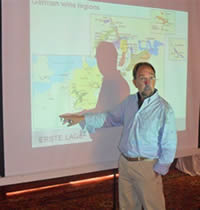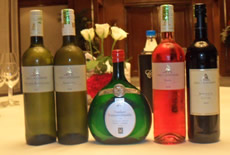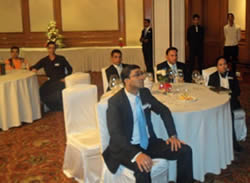 Introducing Joel Payne to the group of about 25 which included a few members of the Delhi Wine Club, Subhash Arora, President of the Indian Wine Academy asked him to paint a wider canvas as wines from Franconia, the northern region in Bavaria were not yet known to many people in India. Introducing Joel Payne to the group of about 25 which included a few members of the Delhi Wine Club, Subhash Arora, President of the Indian Wine Academy asked him to paint a wider canvas as wines from Franconia, the northern region in Bavaria were not yet known to many people in India.
Before talking about the 13 German regions that include the better known Mosel, Rheingau, Rheinhessen and Nahe etc, Joel did a warm-up act by informing the participants about how champagne was made a sparkling wine because the quality of wine made it difficult to enjoy it as such. The crowning of the kings took place in Reims in Champagne and this was the second factor in the promotion of the bubbly. The nobility that came for such events would buy a few cases of champagne whenever they came, just for fun. This was enough of a reason for the commoners to start buying it.
Barely a century ago, German wines were considered premium wines, better than French- some lot more expensive than even the First Growths, he explained. They were certainly considered superior to Spanish and Italian wines. As an example, he talked about an old wine list that he had come across. The 1913 list mentions ‘Sonnenuhr’ wine from the well-known Mosel vineyard. This Riesling (incidentally the grape was not mentioned on the bottle then as it was known that it would be always a Riesling, like Chablis would always have Chardonnay as the grape varietal) was priced at 17 Reichsmarks. In contrast, the First Growth from Bordeaux-Chateau Lafite was priced at only 9 Reichsmarks- practically half the price.
He talked about the Edelzwicker wines- Edel means noble and Zwicker is ‘mixture’. Therefore, Edelzwicker wines which were earlier known to be produced in Alsace were made from the noble grape varietals as blends and were popular in the Eighties’ Germany-being drier than the more popular sweeter wines of the period. Also the villages had different connotations than now-for instance Bingen wine would imply only that the wine was bottled or exported from that village.
Moving from the history of German wines, he took the audience to exactly a hundred years ago to 1910 when the VDP- Verband Deutscher Qualitäts- und Prädikatsweingüter was formed. This literally means- The Association of German Quality and Prädikat Wine Estates. It was formed to keep much more strict quality specifications than were allowed by the German laws which, incidentally, had been changed in 1971 and even today cause a lot of confusion not only throughout the world but also within Germany itself.
Earlier, wines from the VDP member estates were auctioned and not sold. There are about 10,000 producers in Germany with about 4000 working full time in grape growing, said Joel. About 200 estates only are members of this prestigious organisation. Between themselves, they own about 9900 acres of vineyards, being about 4% of the total acreage. But due to the controlled yields, their output is only 2%. Signifying the high quality, the price, however, is 8% of the total value of wines sold.
He also tried to shatter the myth that Germany was only a white wine producing nation. ‘It is the third largest producer of Pinot Noir in the world-after Burgundy and the US, more than Australia and New Zealand combined together,’ he informed the avid listeners.
He talked about the steep vineyards of Germany and the river reflections of the sun, which helped the vines of Germany as also in Franconia which he said, was helped with global warming. Bordeaux had a maximum alcohol content of 12% three decades ago, but today it is difficult to find wines with less than 13.5%, he said.
 Graf van Schönborn is a VDP estate in Franconia whose four wines were tasted under the guidance of Joel, in addition to a Silvaner premium wine from the well known cooperative GWF. Weisserburgunder Kabinett and the Riesling Kabinett 2009 were the two whites tasted before the GWF Silvaner. Graf van Schönborn is a VDP estate in Franconia whose four wines were tasted under the guidance of Joel, in addition to a Silvaner premium wine from the well known cooperative GWF. Weisserburgunder Kabinett and the Riesling Kabinett 2009 were the two whites tasted before the GWF Silvaner.
Weisserburgunder or the Pinot Blanc had the withdrawn and subtle aromas which many people like, said Joel. This grape is fermented without the touch of skins or wood. It is not a wild but easy drinking wine. Nobody would rave about it, but everyone would like it. Riesling –the semi aromatic variety with pears and apricot and earthy, herbal flavours, had a wonderful acidity that made it a very vibrating wine. You love it or hate it-opined Joel based on his years of experience of tasting thousands of Rieslings from all the regions of Germany and other countries. This would be good match with slightly greasy food, he felt.
Silvaner from a single vineyard from GWF winery was a dry Silvaner made from a Spätlese harvest. Touching briefly on the confusing subject of Kabinett, Spätlese, Auslese, Beerenauslese and Trockenbeerenauslese classification system for wines, he quoted the well known British wine critic, journalist and author Hugh Johnson, who feels that there should be a Chair for someone who can explain the German labels in a simple manner. He talked also about the special, trademarked, fat, flatted bottle from Franconia (known as bocksbeutel) in which this wine had been bottled. Explaining that many people do not like the storage issue with this bottle shape, he did agree that world’s worlds’ best Silvaner perhaps comes from this region and it is rightly perceived as a Silvaner region. The concentrated wine was complex and long and had nice and fresh acidity though it was not as spicy.
 Going through the Rose and the Red cuvee made from the local Domina grape and Pinot Noir, he clarified that Domina was an early ripening grape which was nothing much on its own but when blended with Pinot Noir, it made a rather interesting wine. Going through the Rose and the Red cuvee made from the local Domina grape and Pinot Noir, he clarified that Domina was an early ripening grape which was nothing much on its own but when blended with Pinot Noir, it made a rather interesting wine.
There were a lot of interesting questions from the audience and even though we had been running late, Joel patiently answered as many questions from the audience as time permitted. A seminar that was highly beneficial and useful according to Parag Tripathi, a member of the Delhi Wine Club. ‘I am glad I took time out and came here today,’ he said before rushing back to the office where this eminent lawyer had many people waiting for him to discuss court cases for the next day. !
Subhash Arora |